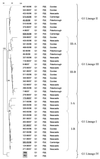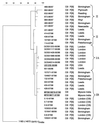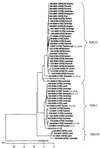Reassortment in vivo: driving force for diversity of human rotavirus strains isolated in the United Kingdom between 1995 and 1999
- PMID: 11264359
- PMCID: PMC114861
- DOI: 10.1128/JVI.75.8.3696-3705.2001
Reassortment in vivo: driving force for diversity of human rotavirus strains isolated in the United Kingdom between 1995 and 1999
Abstract
The G and P genotypes of 3,601 rotavirus strains collected in the United Kingdom between 1995 and 1999 were determined (M. Iturriza-Gómara et al., J. Clin. Microbiol. 38:4394-4401, 2000). In 95.4% of the strains the most common G and P combinations, G1P[8], G2P[4], G3P[8], and G4P[8], were found. A small but significant number (2%) of isolates from the remaining strains were reassortants of the most common cocirculating strains, e.g., G1P[4] and G2P[8]. Rotavirus G9P[6] and G9P[8] strains, which constituted 2.7% of all viruses, were genetically closely related in their G components, but the P components of the G9P[8] strains were very closely related to those of cocirculating strains of the more common G types (G1, G3, and G4). In conclusion, genetic interaction by reassortment among cocirculating rotaviruses is not a rare event and contributes significantly to their overall diversity.
Figures





Similar articles
-
Reassortment of Human and Animal Rotavirus Gene Segments in Emerging DS-1-Like G1P[8] Rotavirus Strains.PLoS One. 2016 Feb 4;11(2):e0148416. doi: 10.1371/journal.pone.0148416. eCollection 2016. PLoS One. 2016. PMID: 26845439 Free PMC article.
-
Molecular epidemiology of contemporary G2P[4] human rotaviruses cocirculating in a single U.S. community: footprints of a globally transitioning genotype.J Virol. 2014 Apr;88(7):3789-801. doi: 10.1128/JVI.03516-13. Epub 2014 Jan 15. J Virol. 2014. PMID: 24429371 Free PMC article.
-
Sequencing and phylogenetic analysis of the coding region of six common rotavirus strains: evidence for intragenogroup reassortment among co-circulating G1P[8] and G2P[4] strains from the United States.J Med Virol. 2011 Mar;83(3):532-9. doi: 10.1002/jmv.21977. J Med Virol. 2011. PMID: 21264876
-
Rotavirus epidemiology and surveillance.Novartis Found Symp. 2001;238:125-47; discussion 147-52. doi: 10.1002/0470846534.ch9. Novartis Found Symp. 2001. PMID: 11444024 Review.
-
Serotype diversity and reassortment between human and animal rotavirus strains: implications for rotavirus vaccine programs.J Infect Dis. 2005 Sep 1;192 Suppl 1:S146-59. doi: 10.1086/431499. J Infect Dis. 2005. PMID: 16088798 Review.
Cited by
-
Molecular Characterization of Human Rotavirus from Children with Diarrhoeal Disease in Sokoto State, Nigeria.Mol Biol Int. 2016;2016:1876065. doi: 10.1155/2016/1876065. Epub 2016 Mar 9. Mol Biol Int. 2016. PMID: 27051531 Free PMC article.
-
Rotavirus genotype distribution during the pre-vaccine period in Bolivia: 2007-2008.Int J Infect Dis. 2013 Sep;17(9):e762-7. doi: 10.1016/j.ijid.2013.03.016. Epub 2013 May 17. Int J Infect Dis. 2013. PMID: 23688547 Free PMC article.
-
Microarrays for genotyping human group a rotavirus by multiplex capture and type-specific primer extension.J Clin Microbiol. 2003 Nov;41(11):5153-8. doi: 10.1128/JCM.41.11.5153-5158.2003. J Clin Microbiol. 2003. PMID: 14605152 Free PMC article.
-
High incidence of G9P181 rotavirus infections in Italian children during the winter season 1999-2000.Eur J Epidemiol. 2003;18(7):711-4. doi: 10.1023/a:1024884103757. Eur J Epidemiol. 2003. PMID: 12952148
-
Rotavirus infection: a perspective on epidemiology, genomic diversity and vaccine strategies.Indian J Virol. 2011 Jun;22(1):11-23. doi: 10.1007/s13337-011-0039-y. Epub 2011 Jun 14. Indian J Virol. 2011. PMID: 23637497 Free PMC article.
References
-
- Blackhall J, Fuentes A, Magnusson G. Genetic stability of a porcine rotavirus RNA segment during repeated plaque isolation. Virology. 1996;225:181–190. - PubMed
-
- Browning G F, Snodgrass D R, Nakagomi O, Kaga E, Sarasini A, Gerna G. Human and bovine serotype G8 rotaviruses may be derived by reassortment. Arch Virol. 1992;125:121–128. - PubMed
Publication types
MeSH terms
Substances
LinkOut - more resources
Full Text Sources
Other Literature Sources

